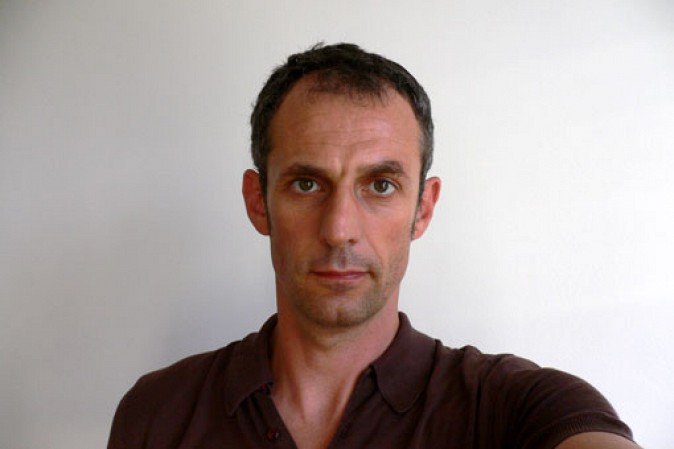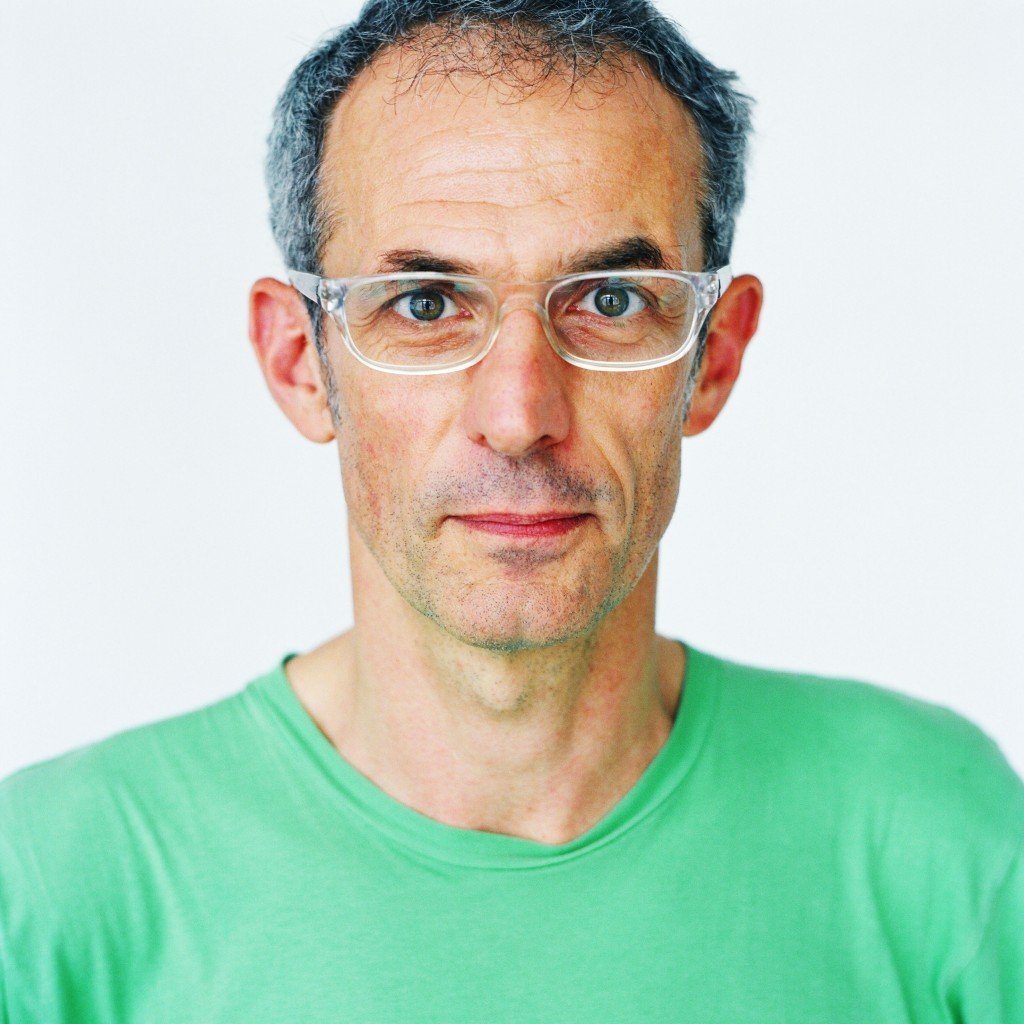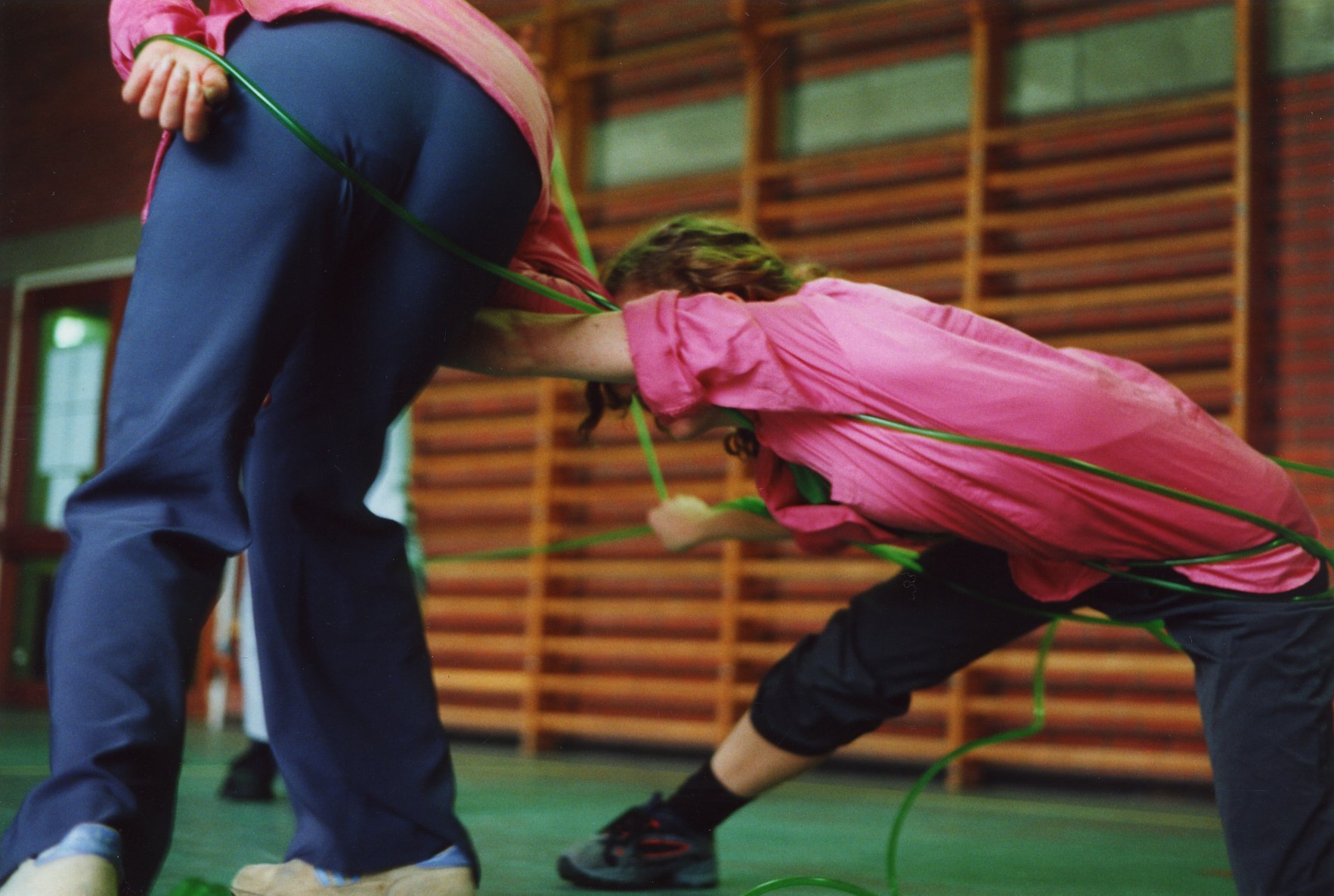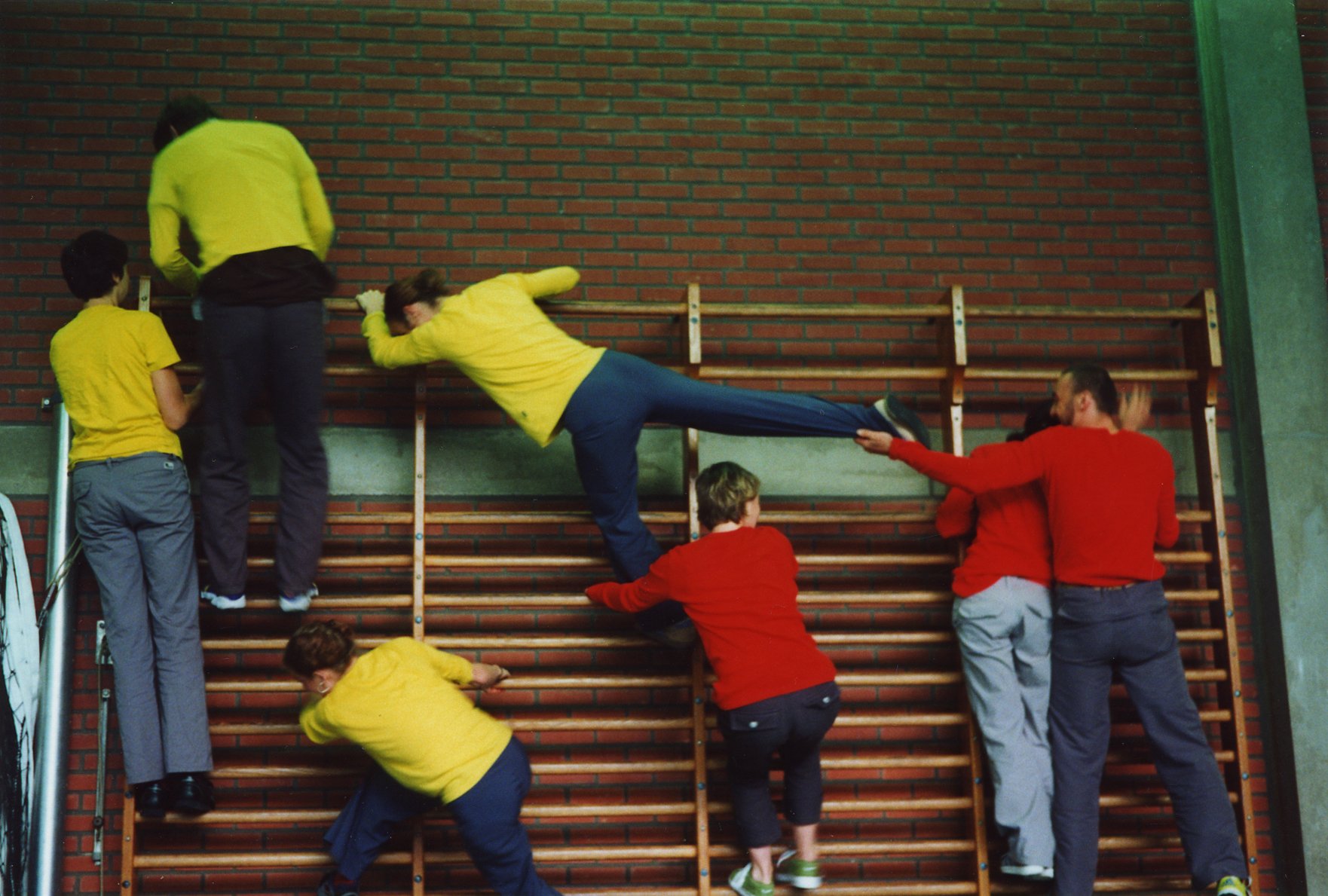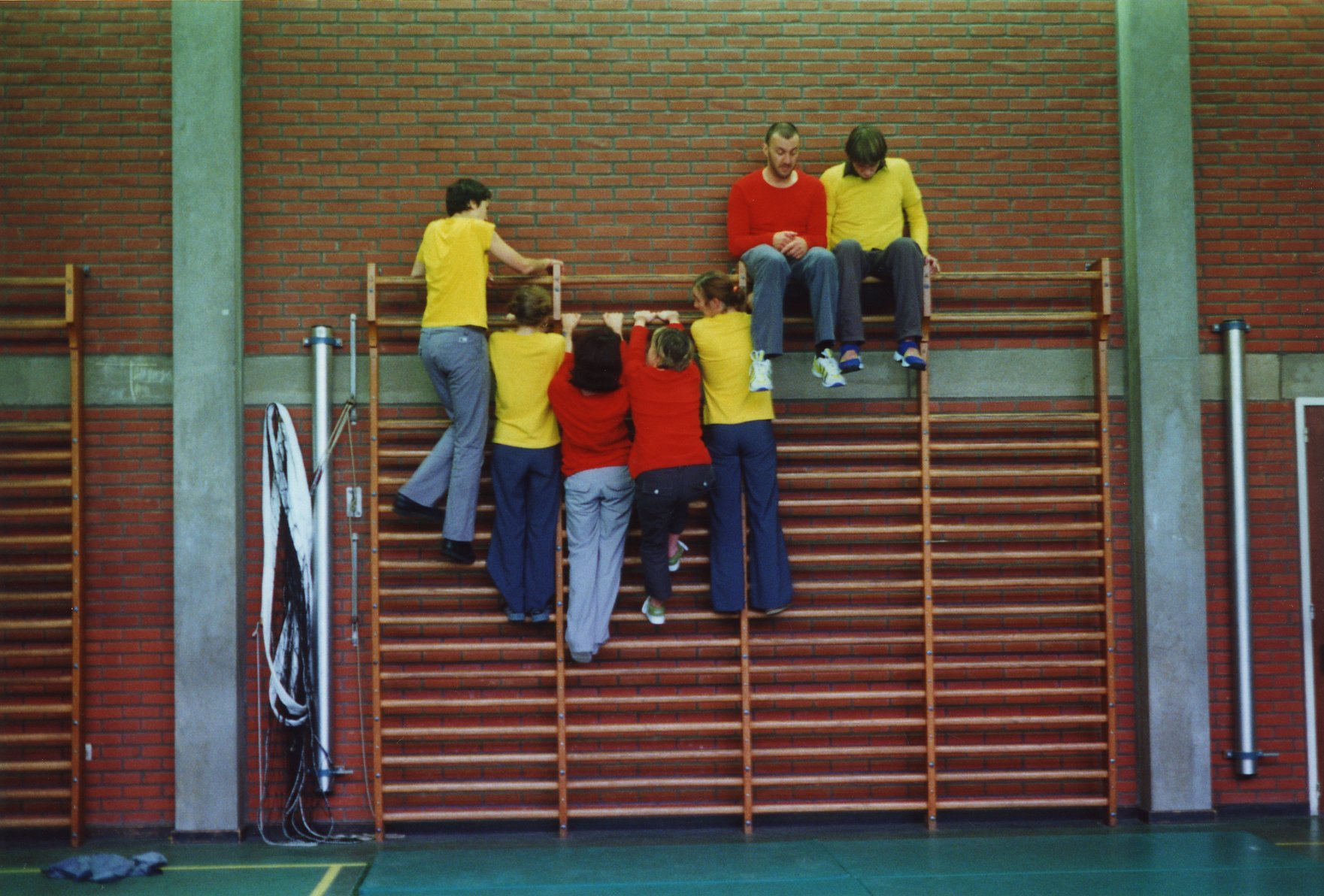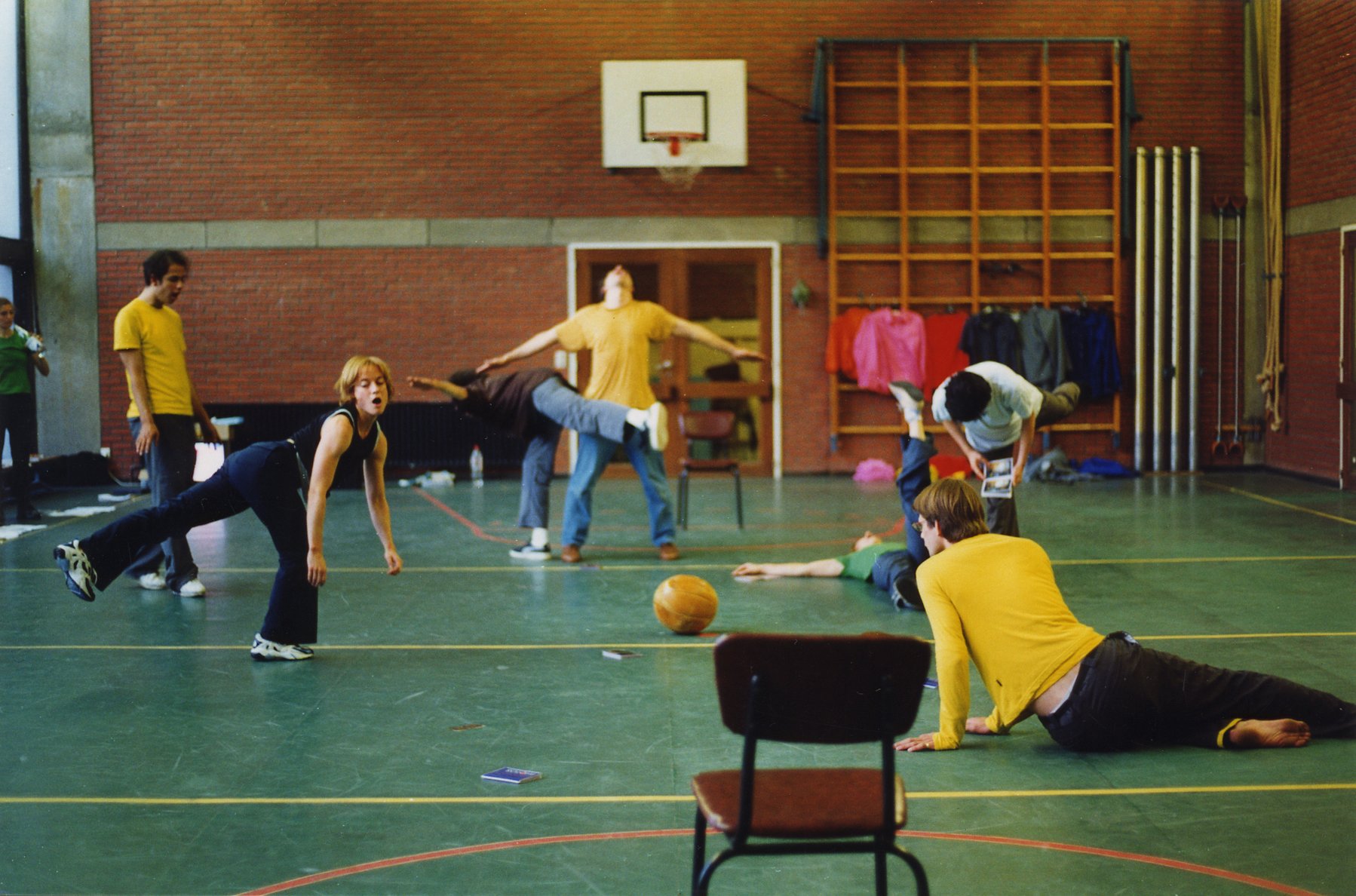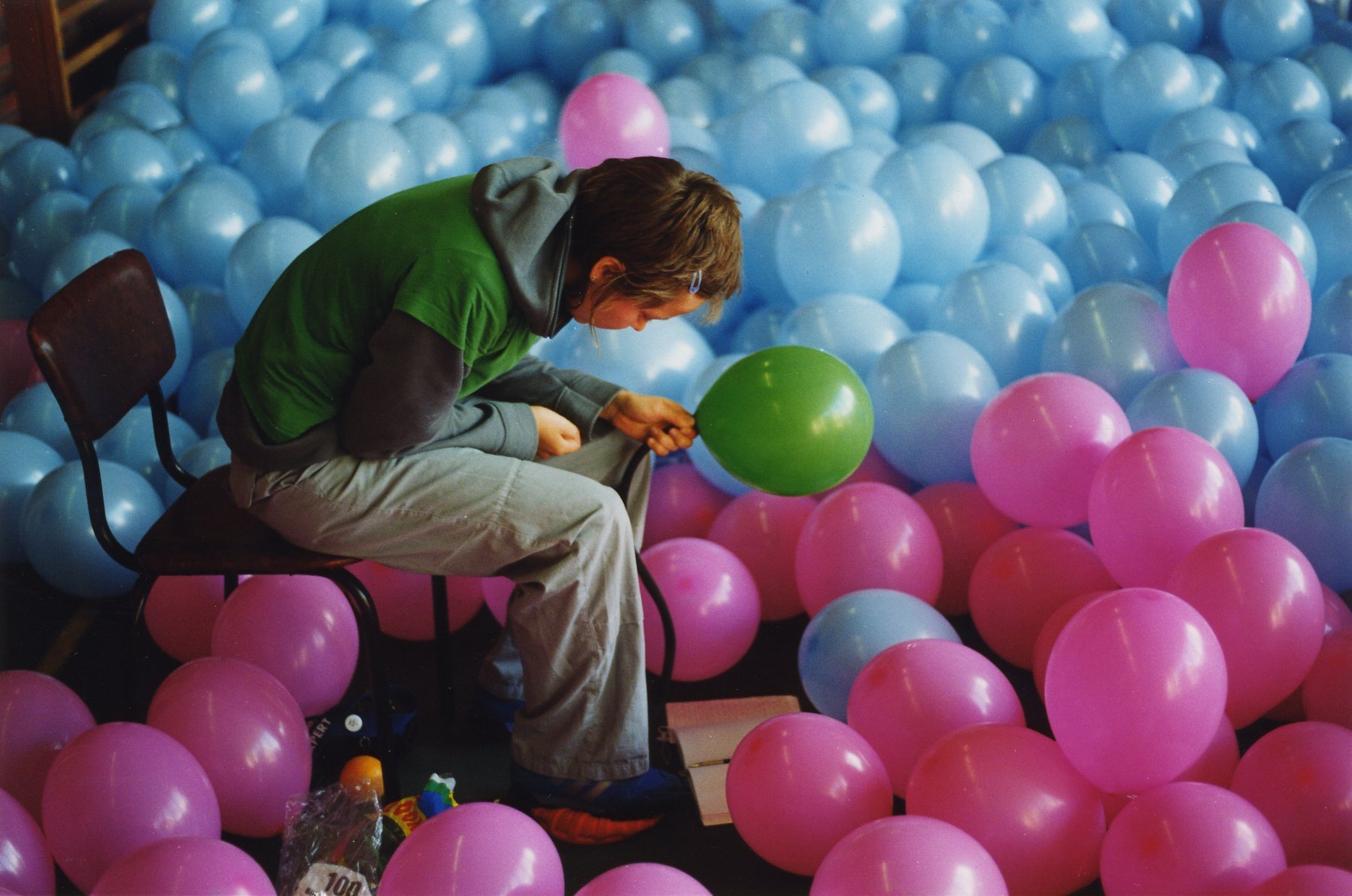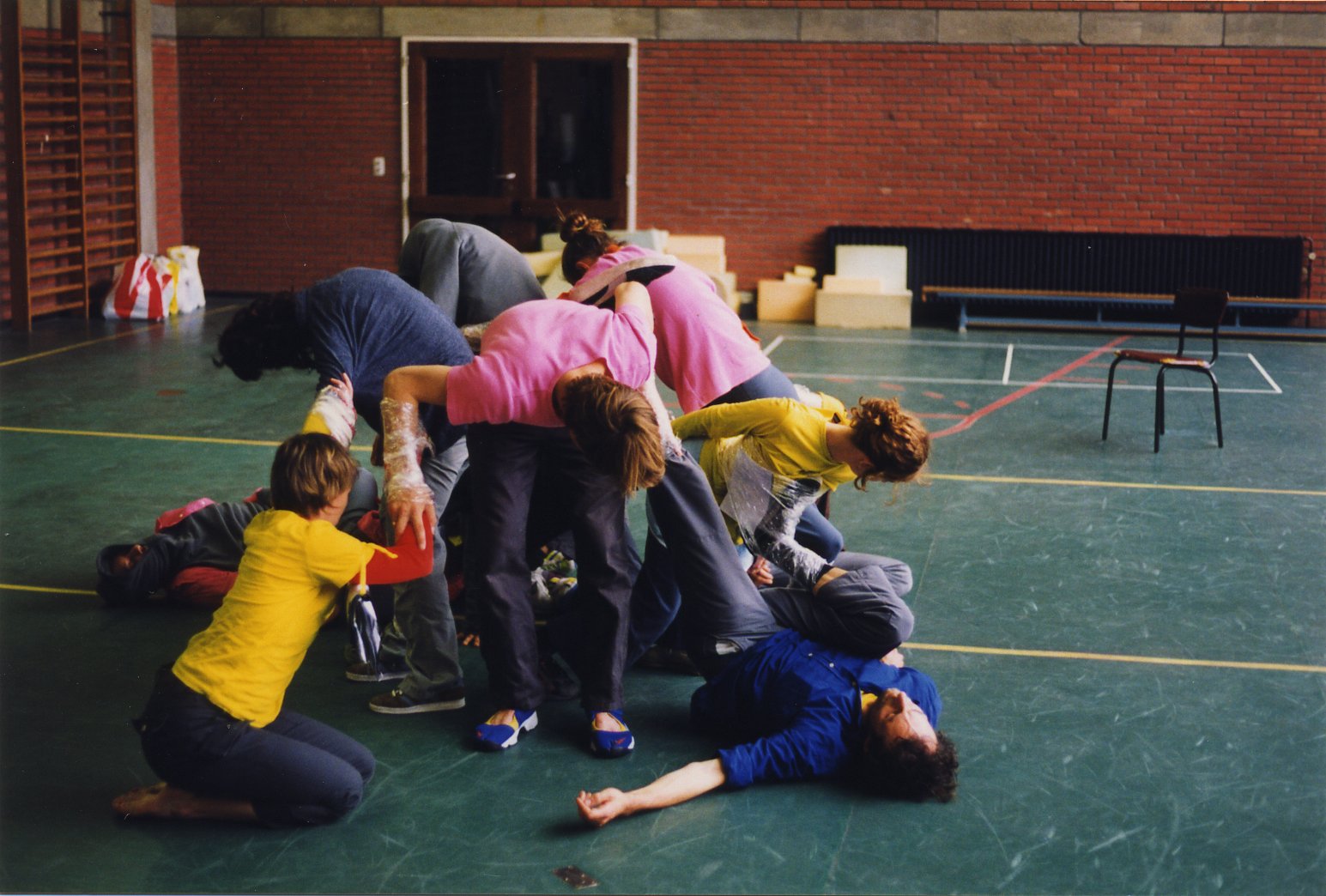Self-Interview, 27.11.2000
Xavier Le Roy
Introduction:
The text “Self-Interview,” written for the performance with the same name, was presented for the first time during the event “E.X.T.E.N.S.I.O.N.S #2.7” in Berlin at the Podewil on the 7th of December 2000. The set for the performance is a simple, square table, a chair, and a ghetto blaster. The performer is sitting at the table with the following text (S-I) and a pile of flyers containing a series of statements on games (see footnote). The audience is invited to take place around the table and the performer begins by playing the tape inside the tape recorder while asking the questions (marked by “Y” in the text) to the ghetto blaster, which in its turn provides answers (marked by “X”). This conversation between human and machine continues until the tape is changed (immediately after “X22”), and then all the questions and answers are performed by the ghetto blaster. In the middle of “Y23,” the performer stands up, and begins handing out the flyers to the audience. He then moves into the auditorium and listens to the text until the end. This set-up tries to reflect or give a “form” to the content of a text that mainly deals with the concept of circulation of ideas, as well as certain concepts about the human body. It can also be regarded as a kind of introduction to other projects presented in the framework of the evenings entitled “E.X.T.E.N.S.I.O.N.S.,” although this performance was originally performed within a different theatrical context and a specific conference situation.
X1: What should we begin with?
Y1: Maybe with the beginning or the origin of this project called Extensions. Because that is why we are here. So, what made you initiate this project, and how did it begin?
X2: I don’t know exactly how and when the project began. But I remember that at the time my major question concerned the relationship between the production and the product within the process of dance or theater performances.
At the same time, I was also questioning whether the representation of a conception of the body and the very production of this representation could be seen as independent. I noticed that, in analogy to an experimental set-up, an artistic production cannot be reduced to anything but to its constitutive elements. That’s why it is necessary to include as many as possible of these constitutive factors as inherent questions in the work. This might be a way to avoid separating the topics, the context, and the representations of the whole working situation. (Thanks to Isabelle Stengers.)
Y2: This sounds very confused and almost incomprehensible to me. Could you be a bit more specific, for example: which conception of the body are you talking about?
X3: I don’t know, but I wanted to associate what I had noticed about different ways of setting up artistic productions with the necessity to consider some perceptions of the body within their complexity and their contexts of representation.
Y3: This sounds very confused and almost incomprehensible for me. Could you be a bit more specific, for example: which conception of the body are you talking about?
X4: I don’t know exactly. But I wanted to set up an arrangement that tries to consider the parameters involved in the process of production, in order to undertake what I would call “a critique of their separation.” For example, I wanted to question the chronological aspects of the working process as well as propose a concept of the body which would neither privilege the body over than the mind or vice versa, nor privilege one body part over any other, nor favor the signs and senses belonging to the human body over the non-human ones.
EXTENSIONS#1-Laboratorium. Images: ©Stefan Pente
Y4: This sounds very confused and it is almost incomprehensible to me. Could you be a bit mor specific: for example, which conception of the body are you talking about?
X5: I don’t know. But very often I ask myself why our bodies should end at the skin, or at best include other beings, organisms, or objects, as encapsulated by the skin?
Y5: I don’t know either, but you might talk about the fact that the body image is extremely fluid and dynamic. That its borders, edges, or contours, are “osmotic,” and that they have the remarkable power of incorporating and expelling outside and inside in an ongoing interchange?
X6: Yes. As you say, body images are able to accommodate and incorporate an extremely wide range of objects and discourses. Anything that comes into contact with the surfaces of the body and remains there long enough will be incorporated into the body image. For example, clothing, jewelry, other bodies, objects, texts, songs, etc. All of this can mark the body, its gaits, its postures, its talks, its discourses, its positions, etc., temporarily, or more or less permanently. Persons, for instance, do not walk the same way or have the same posture when they are naked as when they wear clothing.
Y6: So, in other words what you say is that the body image is as much a function of the subjective psychology and socio-historical context as of anatomy. And that there are all kinds of nonhuman influences woven into us.
EXTENSIONS#1-Laboratorium. Image: ©Stefan Pente
X7: Exactly. So, there must exist another body image than the anatomical one.
Y7: Could you give me an example?
X8: For example: I believe the body could be perceived as a space and a time for trade, traffic, and exchange. (Thank you Elisabeth Grosz for this proposal.)
Y8: This seems like a very simplistic and even simple-minded idea. What you say is that the body image can shrink or expand, that it can give parts to the outside world and can take other parts into itself. Could you explain what this way of perceiving the body means to you?
X9: I don’t know. This idea implies that each individual is perceived as an infinity of extensive parts. In other terms, there would be only composed individuals. An individual would be a notion completely devoid of sense. Some body parts leave my body, enter into another relation, a relation with anything, the mosquito’s relation when it pikes me ... I constantly integrate parts into my relations, for instance, when I eat, I appropriate extensive parts. What does it mean to appropriate parts? To appropriate parts means: that they leave their previous relation and enter into a new one, this new relation being one of my relations, that is: with the meat I make my own flesh. It’s horrible! So what? We have to live (laugh), it never stops: shocks, appropriations, and transformation of relations – compositions ad infinitum, and so on. This system of exterior parts never stops reacting, and at the same time the infinite ensemble in which they inserted never ceases to change, and this is precisely the system of inadequate ideas, confused perceptions, and passive affections, affections-passions. In other words, because I am composed of an ensemble of an infinity of infinite ensembles of extensive parts, I never stop perceiving exterior stuff – perceptions of myself in relation to exterior stuff. Perceptions of exterior stuff in relation to myself, and this is what makes up the world of signs. (Thank you Deleuze, thank you Spinoza.)
Y9: OK, let’s cool down a bit and go back to the beginning.
Rewind tape until the beginning.
X10: So, what should we begin with?
Y10: Maybe by the beginning or the origin of this project called Extensions. Because that is why we are here. What made you initiate this project, and how did it begin?
X11: I don’t know. The origins of the project are multiple, and it developed in many different phases. But I think that the very first step was to write an application asking for subsidies.
Y11: To whom did you address this application, and could you make a chronological description of the project?
X12: Well, I just said that the first phase was to write down my questions concerning choreography in order to ask for subsidies to the Senat für Kultur, Forschung und Wissenschaft in Berlin. I asked for what is called a “Basis Förderung,” which is a two-year support. For this I first founded a company named “in situ productions” together with Petra Roggel. In situ productions received a support of 100.000 DM each year for 1999 and 2000. After this good news I sent an invitation to about 20 persons asking them to take part in EXTENSIONS. So, this letter was actually the second formulation of the project. In between Iasked Stefan Pente to collaborate on the first phase of the project. The project contains two major phases. The first one was called EXTENSIONS #1 and it took place in Berlin during the festival Tanz im August, and after that it moved to Antwerp and became part of the exhibition project “Laboratorium.” The second phase of the project has been developing since the end of 1999 in diverse projects initiated by different participants. My proposal was that the participants could realize transformations, reproductions, developments, recyclings, or critiques based upon the first period of work, or in relation to the general idea of the project.
These projects are part of EXTENSIONS and are produced with the subsidies from in situ productions that were obtained from the Senate of Berlin and with the help of the Podewil and the Tanz Werkstatt. This is a very important parameter of the project because it is trying to actively question the politico-economic and cultural context within which we are working. The pieces you will be able to see tonight are part of this project.
EXTENSIONS#1-Laboratorium. Image: ©Stefan Pente
Y12: What were the ideas and questions that you proposed to the participants?
X13: The proposals and general ideas were formulated like this, in the words of the first invitation that I sent to the participants: Experiments and investigations about human and non-human bodies as extensions one from another, using “movement-based art,” their performances and representations. Performance of the relationships between the “products” and modes of production of these experiments and investigations in the field (time and space) of their development. Transformations and recycling of these investigations by “others” in a second period.
Later, in another letter, I proposed a kind of definition for E.X.T.E.N.S.I.O.N.S.: We could think about “E.X.T.E.N.S.I.O.N.S.” as an organizing idea or concept to work and simultaneously think on questions about performance, body representations, and being at the same time a performance.
Y13: Could you explain why you made these proposals?
X14: During the process of work for the production of a dance piece there is usually a cut or a gap between the rehearsal period and the public representation. It’s a sort of blind pathway from private to public. It is a delicate question and at the same time it can’t be ignored. You can’t escape it. I don’t accept the dissociation between rehearsals and performance because I think that you cannot separate the representation of the bodies from the set-up you used to develop these representations. I would like to handle the question about this pathway during and within every moment of the production. So, what I proposed is to work globally, and at the same time on the complex problem of the processes during the performance and its production.
Y14: Somehow it seems that what you speak about is what is proposed and showed in any representation using the principle of improvisation?
X15: Somehow you are right. But there are some differences. Because I think the kind of improvisation you refer to is used as a method for spontaneous composition, and this, generally, displays an aesthetic, body images, and rules that are specific to this spontaneity. This type of representation reveals fundamental questions, but its form depends too much on that we take a shared and common bond between private and public actions for granted. And I think this is an incomplete answer because it favors the individual surprise in the hope that it will be a collective one. I don’t think this is an assumption that cannot be made with respect to an audience. In fact, this is a problem that we also had during E.XT.E.N.S.I.O.N.S. #1, for instance when the use of the freedom to act was transformed into a representation of freedom. And from my point of view, this was the failure of the project.
Y15: So, it seems that you had some precise goals and desires to be fulfilled. Isn’t this a paradox if you think of how the project was formulated? Did you have specific expectations?
X16: I don’t know. I wanted to work somewhere in between the types of work processes that each of us knew and practiced, in order to find new ones. I hoped that we could concentrate on the questions and problems that I had proposed, without taking refuge in the comfortable habits of known experiences that we could infinitely repeat.
Y16: Did you find something?
X17: I don’t know. I think that sometimes we went through moments containing some elements of an answer. But the first period of work (E.X.T.E.N.S.I.O.N.S. #1) brought up new questions and showed the difficulties in working on my proposals. The major results, I guess, was that it showed that some things were impossible. Maybe because it was a utopia and like every utopian project, it combined the imaginary and the rational. So, it was ambivalent, and a source of paradoxes. (Thanks to Michel Bernard.)
EXTENSIONS#1-Laboratorium. Image: ©Stefan Pente
Y17: What kind of paradoxes and difficulties appeared, and why do you talk about failure?
X18: I don’t know. Maybe it is because I wanted to create a zone of cohabitation of some ideas, which at first sight looked contradictory. And I think I was looking for something like a “discipline of the unknown” to escape the necessity of using knowledge as the only tool. This was a kind of a poisoned gift that I gave to the participants. It was a bit like giving something that I didn’t want to people who didn’t want it. (Thank you, Lacan.) Therefore, the first phase of the project was indeed likely to fail.
Y18: Can you tell why you think that your proposal was a poisoned gift?
X19: I don’t know. My proposals were maybe too totalitarian, they took away the power from the participants while at the same time offering them an illusion of a possibility for expression. And maybe this created alienation within the group. My proposals were sometimes seen as an obstacle to self-expression. And I think that came from a kind of aesthetic fetishism or belief in expressive clichés. The method of work that I wanted to escape is very often structured by dichotomies like: Knowledge / intuition, conscience / sensation, emotion / abstraction, body / mind, setting / improvising, Control / expression... and many other similar ones. But in fact, we never really escape those forms of practice.
Y19: Maybe you are not clear enough in your proposals and your expectations?
X20: I don’t know. I wanted to work somewhere in between the types of work processes that each of us knew and practiced, in order to find new ones. I hoped that we could concentrate on the questions and problems that I had proposed, without taking refuge in the comfortable habits of known experiences that we could infinitely repeat.
Y20: So, what happened?
X21: I don’t know. Maybe I was wrong, but I refused to use the methods of work we all know and usually practice, not to impose another one but to try to find new ones.
EXTENSIONS#1-Berlin. Images: ©Stefan Pente
Y21: So could you tell more about the method of work you are referring to?
X22: I don’t know. But, for example, the use of improvisation very often means to make a selection of moments, which should be the answers to a certain question. But more generally I refer to the usual ways of working that each of us were socialized in through education and environment. I think those methods have to be fundamentally questioned if we are to move forward in the process of production and product in the performing arts. So, I proposed to stay in “unknown spaces” situated in between these different practices. But to be able to represent, we also need to classify, to locate, to fix, and to recognize. And this necessity led us into a confusion between research, knowledge and power. Following this, problems of hierarchy and authority appeared and contaminated the project. Maybe I was more authoritarian than I really needed to be, although without wanting to accept that. Or there was a need for authority within the group, in order to frame and build structures in which we knew how to function. My position as the initiator of the project appointed me automatically to the leadership position. And I didn’t want that. Maybe it was all of this at the same time. And it does not seem compatible with the proposals for the project, and that’s partly why I feel that something failed.
Change tape and put the questions and answers tape.
Y22: So, let’s go back to the principle behind the project. Why was one of the proposals to use the notion of games?
X23: It is difficult to speak exclusively about the ideas on games that were proposed at the very beginning of the project; because it is something that I continued to develop in collaboration with Stefan Pente during workshops that we proposed to diverse audiences. All I will say now relates to the latest experiences. In fact, there are different parameters that made me think about games as a field to explore, and that we could use the notions of games and play as tools to work on different aspects of the project. First, in our society the game is used and seen as an activity involving fictive characteristics, as a secondary reality set apart the daily life, as a part of the unreal. But at the same time, it is wholly a part of our reality. When we play, we choose a role, or a role is assigned to us, where we take part in a situation built up on the basis of rules. This is quite similar to how we act in our daily life within social and cultural constructions. These constructions assign roles to us, but we can also choose them. So, in other terms, in our daily life we also play or perform different roles like in a game. I don’t want to say that games are always a metaphor or a mirror for our life. I see games more as one construction within the constructions we deal with every day, and thus games are interesting to use when we want to explore aspects of roles and performance, both in daily life and in performance. But this apart, I also think that the notion of game is a great tool to be used in working on the “pathway,” on the similarities and differences between both situations. Games are also activities within which it is possible to search and experiment, while at the same time developing strategies to follow and use the rules. So, it is a privileged field for work on body affections, by the constructions they are involved in and vice versa.
X leaves the table and hands out the fliers.
So, what I proposed was not to try to express our personalities and differences, but to use rules of games which assigned roles and allowed the participants to be at the same time active, passive, reactive, and productive, without searching for a special state of creativity. In other terms, games are a field where it is possible to diffract the questions on performance and at the same time to perform them in the realm of fictive and real constructed situations. On the other side there are always non-productive aspects associated to the idea of game. (Thank you Roger Caillois for this remark.) Thus, games seem to be very well adapted to a situation where you do not have the product as the only goal during the production and working process. They give you the possibility to transform the production into the product itself. Another interesting aspect is that each game creates a kind of composition depending on the choices and decisions of the players, and therefore it can be changed anytime. I thought it was very interesting to use the notions of game and play to look for methods of composition, to work on questions of the body and its representations, while at the same time being in a performance situation.
EXTENSIONS#1-Laboratorium. Image: ©Stefan Pente
Y23: One last question. Can you say why you earlier talked about the project EXTENSIONS as a utopia?
X24: I think that the utopian aspect of the project comes from this effort to replace dominant models of behavior and perception by other models. It is a utopia because it attempts to deinstitutionalize the relationships between individuals, and to undo the workings of power in the “spectacular” production chains (or lines). It is a utopian building site, because its goal is to propose another process, another access to, and another perception of, the global system.
Y24: It seems that those utopian aspects could be the source of the difficulties and problems you were previously talked about during the first period of work?
X25: Yes. In fact, there is a “congenital ambivalence” in each utopia, because it associates the imaginary and rationality. This ambivalence derives from four different components in the utopia, which are often hybridized in a perverse way. (Thank you, Michel Bernard.) The first one is: By definition, utopia is a place without place or a non-space. And for Extensions the choice of a gymnasium as a non-rehearsal space and a non-theatrical representation space was a very important aspect in the setting of the project.
The 2nd component is that utopia is a prospective aim to promote a future model. And I already talked earlier about that in the context of EXTENSIONS and the questions on the methods of work. The 3rd aspect is that utopia is always proposed as a radical subversion of a given social or political organization to be replaced by another one, which is presumed to be more ideal. And during the first phase of EXTENSIONS I certainly expected and projected a desire for an ideal organization. But this desire was maybe not shared or not transmittable, because it was caught in a paradoxical relation between the constraints of the proposals and the wish to leave some freedom to the participants. The 4th component is the following: Each utopia presupposes that a new socio-political model necessarily transforms the psychological and moral behavior of each individual taking part in it. This is an inherent reality of a utopia that I didn’t want to accept. But it was impossible to do anything without the active participation from each participant, and yet I didn’t want to impose any such transformation on them. Maybe the participants had been expecting that I would transmit this kind of transformation as if it were a transmission of knowledge. But on one hand, this was exactly the type of social organization that I wanted to change, and on another hand, this necessary transformation was unknown to myself. And maybe this transformation is utopia itself.
Y26: Do you think that a utopia still make can sense for the work you initiated and for a more general or casual situation?
X27: Well, on the one hand, I think that the more utopia seems impossible, the more necessary it becomes. (Thanks to Yvonne Rainer.) On another hand, I think that if utopia still makes sense, it is not as a system or a socio-institutional model to come, but as a singular modality or tonality in a process and a perspective. That is, as qualification of a perception and an action, not as a desired object. In short, as utopian and not as utopia in the historical sense. The utopian implies the presence of the imaginary because fiction is inherent in the sensorial process itself. The utopian is not beyond reality but contaminates reality through the permanent activity of our perception. (Thank you again, Michel Bernard.) That’s why I think it is important to propose methods, organizations, systems, or concepts, which can activate and question the perception within the processes of production in which we are involved, and change the practices we use to survive. That’s what the project EXTENSIONS in all its extensions tries to propose.
Y27: Thank you. I think we can stop with these words on Utopia. Thank you.
X28: Thank you.
The following text was printed on the flyer:
Game as an instant experience and as a gratuitous creativity.
Use of games as a surface for exchange between de- and re- organization of bodies and the languages and codes included in the rules.
Games not to represent our daily life and its problems or some specifics aspects of our society to entertain us. But to propose a process which simultaneously gives access to the experiments, the research, the staging, the performance, and the representation of bodies and
their environment to disembody the authority of simulation.
THANK YOU, HAKIM BEY.
Game as a conscience of immediacy without mediation as a proposal for a method of work and device for representation and performance.


